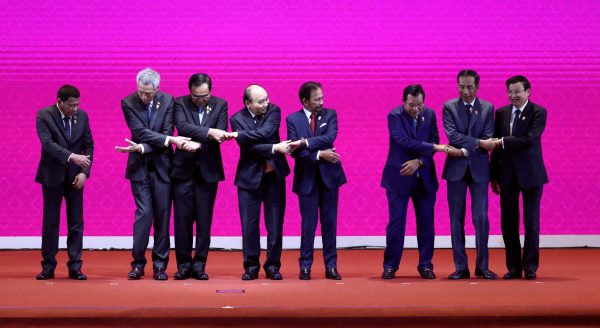Since 2005, the EAS quickly shed its exclusive economic origins, instead becoming an institution with a much wider political and security remit. Political and security issues were at the heart of membership debates from the outset, with China preferring a narrower East Asian membership and Japan seeking to balance China’s political weight by including India, Australia and New Zealand. Japan ultimately prevailed in these membership debates and, following further expansions of the membership in 2011, the EAS today comprises 18 member countries, including all ten ASEAN states together with China, Japan, South Korea, Australia, India, New Zealand, Russia and the United States.
As Melissa Conley Tyler and Rhiannon Arthur note in one of two leads this week, the EAS’s inclusive membership and broad remit give it the potential to be a central regional forum. Its membership includes a mix of Western powers, rising Asian powers and smaller powers who together represent ‘54 per cent of the world’s population and 58 per cent of global GDP’. Conley Tyler and Arthur suggest that such inclusive membership ‘provides a voice to a diverse range of countries in the region, not just to those that have set the agenda in the past’.
At the same time, the EAS’s broad remit makes it a unique platform for countries to come together on the major strategic issues facing the region, issues that by definition cut across political, security and economic concerns. Issues that are high on the agenda of this year’s Summit include the Regional Comprehensive Economic Partnership (RCEP) agreement, ASEAN–China negotiations over a South China Sea code of conduct and, of course, the US–China trade war. Each of these issues — while nominally about trade or maritime security — are connected to deeper questions of great power rivalry, the role of small and middle powers in defining the rules underpinning the region’s order, and the preservation of an open economic order. The EAS can ideally serve as a platform for dialogue and resolution, and an opportunity for leaders to discuss these and other issues on its sidelines.
Yet it is not always clear that the EAS’s broad remit is an asset. Its wide coverage of political, security and economic issues means that its focus can be diluted in contrast with the narrower economic agendas of APEC and the G20. This, coupled with the fact that the EAS has never enjoyed the same institutionalised support as ASEAN or APEC, means that its ability to influence regional cooperation appears limited to date.
Perhaps one of the greatest constraints on the EAS’s influence, however, is that not all major state leaders actually attend. In theory, the EAS Leaders’ Meeting and APEC are scheduled back-to-back in November each year, in order to allow the US President to travel to both meetings in Asia once a year. In reality neither the US or Russian presidents have ever been reliable participants, while China deputises attendance to its premier. As Nick Bisley argues in our second feature this week, participation matters. Watching ‘who comes and how important they are’ will tell us a bit about the place of the EAS in the priorities of the great powers as well as the relative importance of the region in their policy. The White House’s announcement earlier this week that Commerce Secretary Wilbur Ross, rather than President Donald Trump, would lead the US delegation in Bangkok is a clear reminder, Bisley suggests, that, ‘for all the talk of US strategists about the importance of Asia (or, in their preferred terminology, the ‘Indo-Pacific’), most regional states have doubts about US power and purpose in the region’.
Further complicating matters is that November’s APEC meeting, where US President Trump and Chinese President Xi Jinping were expected to sign an interim trade deal, has just been cancelled due to violent protests in the host nation Chile. The cancellation of the APEC meeting increases the pressure on EAS to fulfil its role as Asia’s premier forum for dialogue on the major strategic issues of the day. But the absence of Trump and Xi from the EAS severely undermines its ability to play this role.
Now more than ever the region requires forums such as the EAS to overcome the uncertainty caused by the strategic rivalries between Asia’s major powers. As Bisley argues, ‘in Thailand this year we will see whether it is able to realise the potential inherent in its structure, function and membership to improve Asia’s increasingly contested regional order’.
Both the challenge and potential of the EAS are on full display in Bangkok as the ASEAN plus 6 group struggles to conclude the ASEAN-led Regional Comprehensive Economic Partnership trade agreement. Given the state of global trade policy, as Bisley says, such an outcome would be seen as a major signal that mutually beneficial collaboration can still win through, even in these more contested times. Yet India again presents itself as the non-strategic spoiler.
Thus, while EAS presents as a powerful convening place for trying to conclude what will be one of the world’s biggest free trade agreements and economic cooperation arrangements, it may not yet quite be able to assert the potential inherent in its structure, function and membership to totally make-over Asia’s increasingly contested regional order.
The EAF Editorial Board is located in the Crawford School of Public Policy, College of Asia and the Pacific, The Australian National University.

